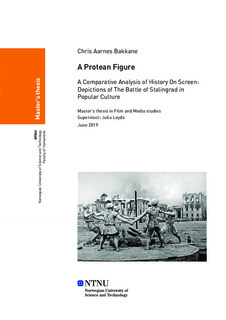| dc.contributor.advisor | Julia Leyda | |
| dc.contributor.author | Chris Aarnes Bakkane | |
| dc.date.accessioned | 2019-11-06T15:02:06Z | |
| dc.date.available | 2019-11-06T15:02:06Z | |
| dc.date.issued | 2019 | |
| dc.identifier.uri | http://hdl.handle.net/11250/2627002 | |
| dc.description.abstract | I denne avhandlingen analyserer jeg og grupperer ulike avbildninger av Slaget ved Stalingrad i populærkulturer, med fokus på kinematiske skildringer av forskjellige nasjoner, blant annet Russland, Tyskland, Amerika og andre vestlige deler av verden. Hovedtemaet for disse analysene gjelder Slaget ved Stalingrad (1942-1943), og den komplekse måten man kan skildre fortiden på lerretet. Den første filmen, Stalingrad (2013), er en russisk film som behandler Stalingrad som et guddommelig minnested for sine borgere. Den andre filmen, Enemy at the Gates (2001), er et samarbeid mellom amerikanerne og europeerne for å gjenopprette historien om en sovjetisk helt gjennom forståelsene til en Hollywood-blockbuster. Og til slutt, Stalingrad (1993), som velger å utfordre måten vi oppfatter Werhmacht-soldatene og deres moralske kamp. Ved å sammenligne disse forskjellige filmene og de særegne aspektene som omfavner estetikk, vold, minne, historie og videospill, kommer jeg frem til at det å skildre krig og historie på både kinolerretet og dataskjermen kan vise seg å være krevende, men nødvendig for å kunne forkynne de grusomme krigshandlingene for en fremtidig generasjon. | |
| dc.description.abstract | In this thesis, I analyse and compartmentalise various depictions of the Battle of Stalingrad in popular media, with focus on cinematic portrayals by different nations, such as Russia, Germany, American and other Western parts of the world. The main subjects for these analyses concern the Battle of Stalingrad (1942-1943), and the complex nature of portraying the past on the screen. The first film, Stalingrad (2013), is a Russian film that treats Stalingrad as a divine site of memory for its citizens. The second film, Enemy at the Gates (2001), is a cooperative effort by the Americans and Europeans to recreate the story of a Soviet Hero through the lens of a Hollywood blockbuster. And lastly, Stalingrad (1993), which opts to challenge the way we perceive the Wehrmacht soldiers and their moral struggles. By comparing contrasting films and distinctive aspects such as aesthetics, violence, memory, history and video games, I surmise that depicting war and history on both the silver screen and the computer screen proves to be a demanding, but necessary to immortalise the devastating nature of war for a future generation. | |
| dc.language | eng | |
| dc.publisher | NTNU | |
| dc.title | A Protean Figure - A Comparative Analysis of History On Screen: Depictions of The Battle of Stalingrad in Popular Culture | |
| dc.type | Master thesis | |
